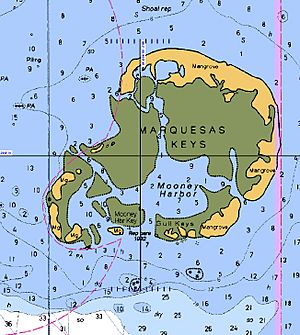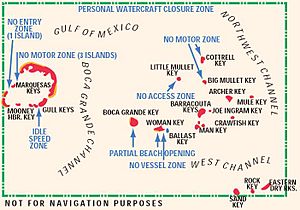Key West National Wildlife Refuge facts for kids
Quick facts for kids Key West National Wildlife Refuge |
|
|---|---|
|
IUCN Category IV (Habitat/Species Management Area)
|
|
| Location | Monroe County, Florida, United States |
| Nearest city | Key West, Florida |
| Area | 189,497 acres (766.867 km2) |
| Established | 1908 |
| Visitors | 180,000 (estimated) (in 2004) |
| Governing body | U.S. Fish and Wildlife Service |
| Website | Key West National Wildlife Refuge |
The Key West National Wildlife Refuge is a huge natural area in Florida, USA. It covers over 189,000 acres, which is about 767 square kilometers. Most of this refuge is water, but it also includes several small islands called keys. These islands are not lived on by people and are special protected areas. The refuge was created to protect many different kinds of birds and other wildlife, especially those that are rare or in danger. It's a safe home for fish, plants, and birds that travel long distances.
This refuge is managed by the U.S. Fish and Wildlife Service. It's one of three refuges looked after by the National Key Deer Refuge team in Florida. Even though there isn't a staff office directly at Key West NWR, a team works hard to keep it safe and healthy for all the animals.
Contents
History of the Refuge
Why Was the Refuge Created?
The Key West National Wildlife Refuge was started in 1908 by President Theodore Roosevelt. Back then, many beautiful birds were being hunted for their feathers, which were used to decorate hats. This hunting was so bad that some bird species were almost wiped out! President Roosevelt wanted to stop this and give the birds a safe place to live and raise their young.
This refuge was one of the very first protected areas in the Florida Keys and one of the earliest in the entire United States. Thanks to places like this, wading birds and many other threatened plants and animals now have a much better chance to survive and thrive. Today, over 250 different types of birds can be found here.
What Makes Up the Refuge?
The refuge is mostly open water, covering more than 777 square kilometers. It also includes about 8 square kilometers of land spread across 26 islands. These islands are part of the Mule Keys and Marquesas Keys.
Most of the islands are covered in mangrove trees, which are special trees that grow in saltwater. There are also a few sandy beaches and sand dunes. These sandy areas are super important because they are where endangered sea turtles lay their eggs. Other parts of the refuge include salt marshes, coastal forests called hammocks, and underwater areas with sea grass beds and coral reefs. All these different habitats provide homes for a huge variety of creatures.
Amazing Animals of the Refuge
Birds of the Florida Keys
The Key West National Wildlife Refuge is a vital spot for over 250 kinds of birds. It's one of the last places in the lower Florida Keys where birds can nest, rest, and find food without being bothered by raccoons. The refuge has large sandy areas around the islands where wading birds love to search for food.
Many different birds live here, including:
- Terns: Small, graceful birds that fly over the water.
- Magnificent frigatebirds: Large, dark birds with long wings and a forked tail. The males have a big red pouch on their throat.
- White-crowned pigeons: Pigeons with a distinctive white cap.
- Ospreys: Fish-eating birds of prey, often seen diving into the water.
- Great white herons: A very large, all-white heron.
The refuge also watches over special birds like piping plovers and bald eagles, which are protected by law. The bird populations here are doing well, which means the refuge is a great success!
Sea Turtles and Their Nests
The sandy beaches of the refuge are crucial nesting spots for several types of endangered sea turtles. These include the Atlantic green sea turtle and the loggerhead sea turtle. It's also the only place in the United States where the critically endangered hawksbill turtle lays its eggs!
Every year, experts check the beaches to count the sea turtle nests. This helps them understand how the turtles are doing. There aren't many beaches suitable for nesting in the refuge, so usually fewer than 50 nests are found each year. It's a good sign that the number of green sea turtle nests has been increasing recently. Even though the total number of nests is small, their activity seems to be steady, which is good news for these amazing creatures.
Visiting the Refuge

There isn't a visitor center at the Key West National Wildlife Refuge. To explore this special place, you need to travel by boat.
While most of the refuge is open, some parts of the beaches on Woman Key and Boca Grande Key are closed to visitors. This is to protect the very sensitive habitats found there. However, the rest of the beaches, including those at the Marquesas Keys, are open during daylight hours. You can enjoy activities like:
- Wildlife observation: Watching birds and other animals in their natural home.
- Nature photography: Taking amazing pictures of the beautiful scenery and wildlife.
- Environmental education: Learning about the importance of protecting these natural areas.
Remember to always respect the wildlife and their home when you visit!



